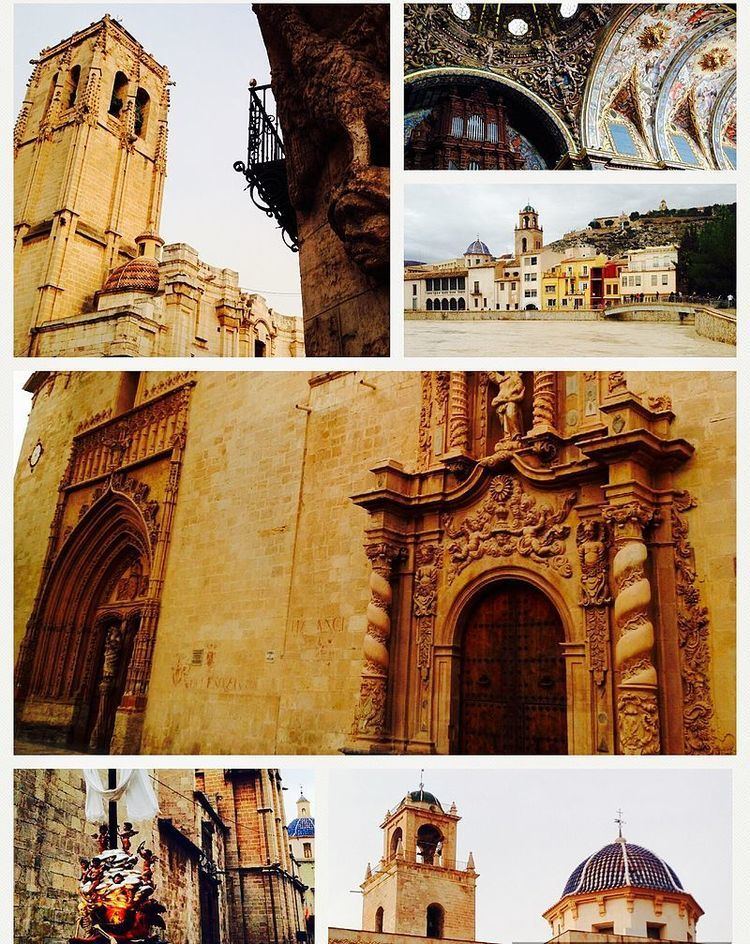Elevation 236 m (774 ft) Population 83,417 (2014) | Judicial district Orihuela | |
 | ||
Demonym(s) Oriolano/a, Orcelitano/a Weather 14°C, Wind NE at 11 km/h, 82% Humidity Points of interest Museo Diocesano de Arte S, Museo de la Semana Santa, Iglesia de las Santas Justa y R, Glorieta Gabriel Miró, Museo de la Muralla | ||
Orihuela spain
Orihuela ([oriˈwela] Oriola [oɾiˈɔla]) is a city and Municipality located at the feet of the Sierra de Orihuela mountains in the province of Alicante, Spain. The city of Orihuela had a population of 33,943 inhabitants at the beginning of 2013. The municipality has a total area of 367.19 km², and stretches all the way down to the Mediterranean coast, west of Torrevieja, and had a total population of 92,000 inhabitants at the beginning of 2013. This includes not only the city of Orihuela, but also the coastal tourist centre (urbanización turística) of Dehesa de Campoamor with 33,277 inhabitants (2013) and a few other villages.
Contents
- Orihuela spain
- Map of Orihuela Alicante Spain
- Costa blanca spain alicante torrevieja la zenia campoamor orihuela costa
- History
- City and suburbs
- Economy
- Main sights
- Famous people
- References
Map of Orihuela, Alicante, Spain
The river Segura flows through Orihuela. The city was settled by Romans who called it Orcelis and subsequently Aurariola.
Costa blanca spain alicante torrevieja la zenia campoamor orihuela costa
History
Orihuela is the capital of the region of the "Vega Baja del Segura" (natural region of the Segura River); it has been the capital of a province and even of a kingdom. The city was named the first city of the province of Alicante, 11 September 1437.
In 576 it was the capital of the Visigothic province of Aurariola, to which it gave its name. In 713 (5 April) the military man and Count Teodomiro, proclaimed himself King of Tudmir.
In 825 the Kingdom of Tudmir, became a dependent kingdom under Umayyad control, and the capital was moved to Murcia. In 910 the Kingdom of Tudmir passed to the Emirate of Cordova.
In 1053 the principality of Murcia, part of the Kingdom of Denia, is created. In 1086 the principality of Murcia becomes independent from Denia. In 1212 the area passed to the Kingdom of Murcia.
In 1304 Orihuela was considered to be on the border between the kingdoms of Castile and Aragón. In 1366 it passed to the kingdom of Valencia.
In 1437, it was declared a city and in 1707, Charles V, Holy Roman Emperor made Orihuela capital of the province of Orihuela. In 1737 Alicante, Elche, Monforte, Jijona, Villajoyosa, Agost, Busot, San Juan or Muchamiel became independent from the province of Orihuela, forming the one of Alicante.
1799 Orihuela was part of the province of Alicante. In 1810, Napoleon made Orihuela part of the Department of Segura with the capital at Murcia. In 1822, Orihuela passed to the province of Murcia. 1833 it became part of the province of Alicante. In 1920 nationalistic movements spoke of Orihuela as belonging to the "Country of Murcia."
Between 1988 and 2006 various research studies from the Universities of Andalusia, Castile and Murcia demonstrated that Orihuela was more culturally part of Murcia than Valencia in terms of phonetics, lexicon, architecture, agriculture, folklore, musical celebrations, instruments, language, burial customs, gastronomy and varieties.
In recent years, there has been growing support for the "independence" of Orihuela Costa (Dehesa de Campoamor) from Orihuela itself. This is due to the perception among the largely foreign born population of Orihuela Costa that they are being unfairly treated by the local government. For example, the Orihuela Costa's share in the 2010-2014 municipal budget was 6x less than that for the city itself, or 4,2% of the 295 million € budget, even though the Costa creates around 30% of municipal tax income.
City and suburbs
The municipality had a total population of 92,000 inhabitants at the beginning of 2013, of which the city of Orihuela only accommodated 33,943 of them. Another major locality within the municipality is the tourist centre of Dehesa de Campoamor, also known as Orihuela Costa, located on the coast, more than 20 km from Orihuela. It had 33,277 inhabitants at the beginning of 2013.
Only 59.6% of the local population are Spanish; the British account for almost 20%, followed by the Irish, Bulgarians and Moroccans, with around 3% each. In total there are people from 106 different nationalities currently living in Orihuela.
The metropolitan area of Orihuela includes the eleven municipalities of Vega Baja del Segura: Benejúzar, Benferri, Beniel, Bigastro, Callosa de Segura, Cox, Jacarilla, Rafal, Redován and Santomera. It had a total population of 151,358 inhabitants at the beginning of 2006, and a total area of 510,3 km².
The municipality of Orihuela include all these villages:
The metropolitan area of Orihuela is also part of the larger Murcia-Orihuela conurbation, with a total population of 727,741 inhabitants (2006) and an area of 1,743.5 km².
Economy
The agriculture of Orihuela is based on lemons, oranges, almonds, olives, palm trees, pomegranates, cotton, hemp and vegetables. It also has an important industry of silk, wool and preserved food. The tourism industry is today the single most important sector in the economy, and as been the main engine of growth for Orihuela in the 21st century.
Main sights
The medieval town center houses five National Monuments and an urban layout that is the result of its former rank as a University Centre and Episcopal See.
The holiday celebrations: the processions of Holy Week, and the parades of Moors and Christians, in July, are well-known celebrations.
In September 2012 the shopping mall La Zenia Boulevard opened and became the largest shopping mall in the Costa Blanca and Costa Cálida region with 150 stores and 20 restaurants and bars.
Famous people
The Spanish poet Miguel Hernández was born in this city, which shares a campus with the University Miguel Hernández. It is also important for its festival of Moros y Cristianos.
